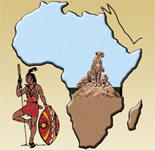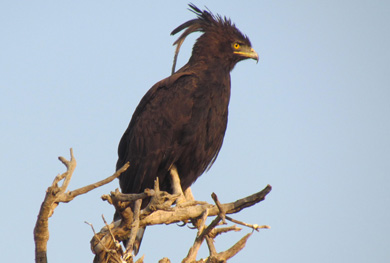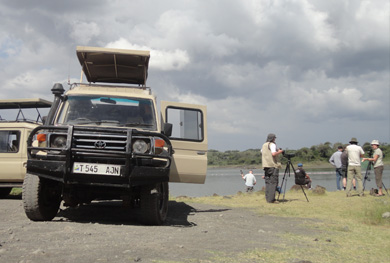15 Days Kenya Tanzania Birding Safari
fromKenya has the second highest birdlist for any African country with over 1000 species, and on this tour we expect perhaps 450 of these Bird Watching Safaris. A birdwatcher`s paradise, teeming with birdlife, with diverse habitats, spectacular scenery you can see 550 to 750 bird species
Morning and Evening Game Drives
Accommodation Options:
Momella Lodge
Tarangire Sopa Lodge
Serengeti Sopa Lodge
Lake Manyara Hotel
-
Reviews 0 Reviews0/5
-
Vacation Style Holiday Type
-
Activity Level
-
Group Size Small Group
15 Days Kenya Tanzania Birding Safari For December Period
 Nairobi –Tsavo West National Park – Amboseli – Arusha– Tarangire – Ngorongoro – Serengeti – Ndutu Area- L. Manyara – Nairobi
Nairobi –Tsavo West National Park – Amboseli – Arusha– Tarangire – Ngorongoro – Serengeti – Ndutu Area- L. Manyara – Nairobi
Day 1: Nairobi – Tsavo West
Departure from Europe destination for overnight flight to Nairobi. On arrival at the Jomo Kenyatta International Airport (morning Flight KQ/KLM Airways arriving at 0700hrs) (J.K.I.A) Airport, you will be met and greeted by our customer service representative and later we will transfer to Tsavo West National Park for a two nights stay at Kitani Safari Camp. En route we will be making several birding stops, of which Hunter’s Lodge most notable. These may produce Black-faced Sandgrouse, Crowned Hornbill, Red-chested Cuckoo, Verreaux’s Eagle-owl, Giant Kingfisher, Nubian Woodpecker, Short-tailed Lark, Northern Brownbul, Eastern Nicator, Spotted Morning-thrush, Lesser Swamp-warbler, Grey-backed Camaroptera, Northern Crombec, Ashy and Lead-coloured Flycatchers, Grey-headed Bush-shrike, African Golden-weaver, Green-winged Pytilia, Peters’s Twinspot and the local Jameson’s Firefinch. Tsavo West is one of the largest parks in the world and is also one of the wildest areas left on the planet. The park consists of many habitat types, but thick bush country is the most prevalent. Avain treats during our stay in Tsavo West may include African Darter, Hamerkop, Tawny and Verreaux’s Eagles, Mottled and African Black Swifts, Spot-flanked Barbet, Cardinal Woodpecker, Green Wood hoopoe, Eastern Yellow-billed Hornbill, Dodson’s Bulbul, Scaly Chatterer, Somali Tit, Mouse-coloured Penduline-tit, Black-billied, Hunter’s, Tsavo and Kenya Violet-backed sunbirds, Pygmy Batis, Brubru, Three-streaked and Black-crowned Tchagra, African Black-headed Oriole, White-naped Raven, Red-billed and Yellow-billed Ox-peckers, Golden-breasted Starling, Black-necked, Village and Red-headed Weavers, Black-capped Social-Weaver, Reichenow’s (Kenya Yellow-rumped) Seedeater and the magnificent Somali Bunting. African Crested Porcupine, Yellow Baboon, Blue Sykes’s Monkey, Black-faced Vervet Monkey, Scrub Hare, Unstripped Ground-squirrel, Black-backed Jackal, Lion, Bush Hyrax, Common (Burchell’s) Zebra, Hippopotamus, Common Warthog, Masai Bushbuck, the elegant lesser Kudu, Klipspringer, Kirk’s Dikdik, Bush Duiker, Bohor Reedbuck, Common Waterbuck, Grant’s Gazelle, Impala, Coke’s Hartebeest and the impressive Fringe-eared Oryx are just a few of the mammals we may locate during our stay in Tsavo West.
Day 2 & 3: Amboseli National Park
Today after our morning breakfast we will transfer you to Amboseli National Park on the southern Kenya for a two-night stay at the lovely Amboseli Sentrim Camp. Before reaching the Amboseli Game Reserve we will pass through some dry scrub country. Here we may find Eastern Chanting-goshawk, Pygmy Falcon, Crested and Yellow-necked Francolins, Buff-crested Bustard, Spotted Tick-knee, Namaqua, Laughing and African mourning Doves, Emerald-spotted Wood-dove, Pearl-spotted Owlet, African Orange-bellied Parrot, White-bellied Go-away-bird, White-headed and Blue-naped Mouse bird, Little Bee-eater, Grey-headed Kingfisher, Northern Red-billed and Von der Decken’s Hornbills, Black-throated, D’arnaud’s and Red-and-yellow Barbets, Foxy (Fawn-coloured) and Pink-breasted Larks, African Bare-eyed Thrush, Ashy and Tiny Cisticolas, Grey Wren-warbler, White-winged Scrub-robin, Beautiful and Mariqua Sunbirds, Northern White-crowned Shrike, Long-tailed and Taita Fiscals, Rosy-parched Bush-shrike, Fischer’s Starling, White-headed Buffalo-weaver, vitelline and Lesser Masked Weavers, Grey-capped Social-weaver, Chestnut Sparrow, Blue-capped Cordon-bleu, Grey-headed Silverbill, Black-faced Waxbill and the extremely local Southern Grosbeak-canary.
Amboseli National Park is home to a wide variety of birds and mammal species and is also one of the best places in the world from which to observe the spectacular Mt. Kilimanjaro, which towers more than 19,000 feet above the plains. Birds that can be seen within the reserve include common Ostrich, Bateleur, Martial Eagle, White-backed and Lappet-faced Vultures, Spur-winged and Egyptian Geese, Red-billed and Hottentot Teals, Long-tailed Cormorant, Red-knobbed Coot, Yellow-billed and Saddle-billed Storks, Great and Intermediate Egrets, Grey, Black-headed, Goliath and Squacco Herons,Black Crake,African Jacana, Grey Crowned-crane, African spoonbill, African Fish-eagle, Lanner Hartlaub’s Bustard, Water Thick-knee, Collared Pratincole, Two-banded Courser, Long toed Lapwing, Three-banded, Kitlitz’s, Blacksmith and Spur-wingled Plovers, Greater Painted-snipe, Chestnut-bellied and Yellow-throated Sandgrouse, White-browed Coucal, Slender-tailed Nightjar, Lilac-breasted Roller, Grey-headed, Malachite and Pied King-fishers, African Hoopoe, Red-capped Lark, Fischer’s Sparrow-lark, Pangani and Rosy-throated longclaws, Zitting and Winding Cisticolas, Speke’s Weaver, Taveta Golden-weaver, Fan-tailed Widowbird and the diminutive Red-billed Firefinch. Some of the many mammals possible in the Amboseli are Yellow Baboon, Black-faced Vervet Monkey, Scrub Hare, Black-backed and Side-striped Jackals, Dwarf Mongoose, Spotted Hyena, Lion, Cheetah, African Savannah Elephant, Common (Burchell’s) Zebra,
Hippopotamus, Common Warthog, Masai Giraffe, Cape Buffalo, Kirk’s Dikdik, Bohor Reedbuck, Common Waterbuck, Thomson’s and Grant’s Gazelles, Impala, Coke’s Hartebeest and possibly the stunning Fringe-eared Oryx.
Day 4: Arusha Overnight
Today with game drive en-route we will depart Amboseli and head to Arusha via Namanga border where we meet our transport and drive to Arusha for overnight at Impala Hotel. Here we are booked on bed and Breakfast for this night. En-route and with time allowing us we will visit the plains of Angyata Osugat in order to search Beesley’s Lark, the ‘Lark Plains’, a rather strange open area situated between Arusha and the border town of Namanga which is home to one of Africa’s rarest birds, Beesley’s Lark. This isolated form of Spike-heeled Lark is critically endangered with a world population of probably no more than 100 individuals. These plains, in the rain shadow of Mt Meru and Mt Kilimanjaro, are perfect habitat for larks and as well as Beesley’s, we’ll look for Pink-breasted, Athi Short-toed, Short-tailed, and Foxy Larks. The open landscape can be good for raptors sometimes with migrant Montagu’s Harriers, Lesser Kestrels and Amur Falcons joining the resident Greater and Common (Rock) Kestrels. In this distinctly dry habitat we can also find savannah species typical of the larger protected areas to the west such as Eastern Chanting Goshawk, African Pygmy Falcon, Chestnut-bellied Sandgrouse, Double-banded Courser, Crowned Lapwing, Abyssinian Scimitarbill, Red-fronted, Red-and-Yellow, and Spot-flanked Barbets, Ashy and Tiny Cisticolas, Purple Grenadier, Eastern Paradise and Straw-tailed Whydahs and Somali Golden-breasted Bunting while mammals we might not have seen before could include Golden Jackal and Gerenuk, and with great luck, Lesser Kudu. Dinner today will be on own arrangements.
Day 5: Arusha National Park.
After breakfast drive we’ll drive into Arusha National Park where we’ll encounter our first African large mammals as we find ourselves amongst Masai Giraffe, African Buffalo, Common Zebra, Common Waterbuck, Bushbuck, Warthog, Black and White Colobus, Blue Monkey, and Olive Baboon. Hiding in the dappled shade of this magnificent evergreen hill forest we may also find a tiny woodland antelope, the secretive Suni, along with the bay-colored Harvey’s Red Duiker. If we are very lucky we may also catch sight of a Leopard or Serval.
There will be much to see during the day. Our first stop will be in the lush forest that cloaks the edge of the ancient volcanic crater. Here we’ll be looking for the massive African Crowned Eagle, as well as Ayres’s Hawk-Eagle, Mountain Buzzard, African Green Pigeon, Hartlaub’s Turaco, Bar-tailed Trogon, White-fronted and Cinnamon-chested Bee-eaters, Moustached Green Tinkerbird, African Palm, Horus, Alpine, Mottled, Little, and Nyanza Swifts, Black Saw-wing, Olive Mountain (Placid), Stripe-cheeked and Mountain Greenbul, Waller’s, Kenrick’s and, if we are very fortunate, Abbott’s Starlings, and Eastern Double-collared Sunbird. Clearing the forest we come to more open areas of scrub, grassland where we’ll encounter a different set of birds with Rufous-naped Lark, Pangani Longclaw, Chin-spot Batis, White-browed Scrub Robin, African Moustached and Cinnamon Bracken Warblers, Trilling and Siffling Cisticolas, and the very local Taveta Golden Weaver. The ancient vocanic craters have created wetlands that will be alive with Lesser Flamingos and this is a reliable site for the normally elusive Greater Painted Snipe. Later we return to the lodge where the peaceful surroundings and the elegantly appointed accommodation will be a wonderfully relaxing way to start our tour. Night in Momella Lodge.
Day 6 & 7: Tarangire National Park.
After a game drive to the Momela Lakes, departure to Arusha, drive through superb scenery to Tarangire where we stay for the next two nights. Tarangire National Park has a mixture of habitats, which we can explore during our time here: there is the dry,open acacia woodland beloved by rollers, bee-eaters and shrikes, where Secretary birds stalk through the long grass and between the spiky shrubs looking for a small lizard or snake. The common birds here include Black-shouldered Kite, White-backed Vulture, Bateleur, Tawny Eagle, Helmeted Guineafowl, Blacksmith Plover, Laughing Dove, Speckled Mouse-bird, Lilac breasted Roller, Common Bulbul, Common Fiscal, Grey-headed Sparrow and Red-billed Quelea. Giant baobabs stand as though planted upside down, and the grassy areas often hold secretive pairs of Heuglin’s Coursers. Spot flanked, D’Arnaud’s and White-headed Barbets all occur here, together with Brown and Orange bellied Parrots. The areas of open water and swamp around the Tarangire River hold Hamerkop, African Darter, Goliath Heron, African Spoonbill and Three-banded Plover. An endemic speciality of the area is the Ashy Starling. Game will be common and we can hope to see herds of Elephant, together with Giraffe, Waterbuck and the delightful Kirk’s Dikdik. Other interesting species to look for here may include: Ashy Starling, Violet tipped courser, Yellow collared lovebird, Red & yellow barbet, Red billed quelea, Mottle throated spine tail, Abyssinian Scimitar bill, Beautiful sunbird, Greater honey guide, African Hawk eagle, Black chested snake eagle, Brown snake eagle, Open bill stork, White faced tree duck, Great white egret. All meals will be at Tarangire Sopa Lodge on full board
Day 8: Ngorongoro Conservation Area.
After breakfast depart to the Highlands of Ngorongoro. The sides of this once vast volcano are now extensive grasslands and as we begin to climb we’ll stop to look for some of the birds that make this their home. These may include secretive African Snipe although much more showy are the numerous Red-collared Widowbirds, the males resplendent in full breeding plumage, as are the less common Jackson’s Widowbirds. Striking male Yellow Bishops will be buzzing over the grass trying to impress the females, and smart African Stonechats will share the bush tops with stunning Malachite Sunbirds. Reaching our lodge perched overlooking the Ngorongoro crater, we should have time for a walk along the rim where we may find Schalow’s Turaco, Golden-winged and Tacazze Sunbird, and the exuberant Hunter’s Cisticola. This is also a wonderful place to see various raptors riding the updraft from the side of the crater, giving eye-level views as they hang motionless. Overnight stay at Ngorongoro Sopa Lodge.
Day 9: Ngorongoro Conservation Area.
The vast Ngorongoro Crater is just one of those places that has to be seen – words alone cannot do it justice. We’ll drive down into the huge sunken caldera, descending into what was once, many eons ago, the fiery heart of a huge volcano. Today this natural amphitheatre has a much more peaceful atmosphere as Wildebeest, Coke’s Hartebeest, Grant’s and Thomson’s Gazelles, and Zebra feed contentedly – or at least as contentedly as the ever present Lions and Cheetah will allow, although the Black Rhinocerous here will be less concerned about these predators. The bird life in the crater varies according to the seasons but during our visit we should see Grey Crowned Crane, Shelley’s Francolin, Abdim’s and Black Storks, Lappet-faced Vulture, Black-bellied and Kori Bustards, Fischer’s Lovebird, Hunter’s and Pectoral-patch Cisticolas, Northern Anteater Chat among many others. Overnight stay at Ngorongoro Sopa Lodge, on the rim of the crater.
Day 10 &11: Serengeti National Park.
After breakfast, we’ll travel northwards into the famous Serengeti National Park and then stay for two nights at the Serengeti Sopa Lodge. As soon as we enter the Serengeti we find ourselves in the Africa of everyone’s imagination – a wide open landscape land of long grass punctuated by ‘koppies’, tall rocky outcrops, scattered acacia trees, and mammals and birds everywhere. As we make our way towards the central part of the Serengeti, there will be plenty to look at. Out on the plains we’ll be looking for Kori and Buff-crested Bustard, Coqui Francolin, the endemic Grey-breasted Spurfowl, Brown Parrot, Yellow-throated Sandgrouse, Freckled Nightjar, Plain-backed Pipit, Sooty Chat, the endemic Tanzanian (Ruaha) Hornbill, Grey-crested Helmet-shrike, Rosy-patched Shrike, Long-tailed Cisticola, Buff-bellied Penduline and Red-throated Tits, and Steel-blue Whydah to mention a few. Among the many mammal species we hope to see are Cheetah, Leopard, and Topi, while Rock Hyraxes and Klipspringer should be found in the rocky koppies and herds of Hippopotamus wallow in muddy pools. We’ll be staying at the lodge which is set on a hillside with views across the plains and woodlands. Here birds like Hildebrandt’s Starlings are common in the grounds, and the morning chorus resounds with calls of hornbills, thrushes and weavers. The Serengeti National Park covers some 12,000 sq km of grassy plains in northern Tanzania and forms a super wildlife sanctuary with the Masai Mara on the Kenyan side of the border. All meals will be at Serengeti Sopa Lodge.
Day 12: Serengeti National Park.- N’dutu Area
This morning we’ll spend the day at the southern end of Serengeti “N’dutu Area”, just on the edge of the Serengeti National Park. The birds are rewarding and range from bulky Kori Bustards to tiny Red-throated Tits. We will be looking for migrating raptors, wheat-ears and shrikes amongst the resident Martial Eagles, Yellow-throated Sandgrouse, Von der Decken’s Hornbill, White-tailed Lark, Yellow-throated Longclaw and Magpie Shrike to name but a few. All the vulture species are represented here – Rüppell’s, African White-backed, Lappet-faced, White-headed, Egyptian and Hooded. The endemic Rufous-tailed Weaver and Grey-breasted Spurfowl are both easily seen around the lodge. There should as well be a host of new birds in the form of Spotted Eagle Owl, Usambiro Barbet, African, Didric, Klaas’s, Great Spotted and Jacobin Cuckoos, Red-fronted and Black-throated Barbets, Silverbird, Schalow’s Wheatear, and Cliff Chat among many other. As our lodge is located in the heart of the African bush, Overnight at Serengeti Sopa lodge
Day 13 & 14: Lake Manyara.
After breakfast we leave Serengeti, and travel to Lake Manyara Hotel, overlooking Lake Manyara National Park, where we stay for two nights. Here we can look for Cut-throat Finch and Green-winged Pytilia amongst a host of other birds and small mammals that come to bathe and refresh themselves. We shall also visit the lake itself looking for Silvery-cheeked Hornbills and Syke’s Monkey, both Lesser and Greater Flamingos, White and Pink-backed Pelicans, and perhaps finding the famous tree climbing lions. The lakeside is often teeming with water birds and we can spend some time here identifying the many storks, herons, egrets, waders and ducks.
Lake Manyara National Park offers varied habitat, but two-thirds of the park is covered by the alkaline when water levels are high. During dry season the lake is virtually non-existent. The remainder is mostly in a narrow strip of land between the Manyara Escarpment to the west and the lake attracts large numbers of Lesser Flamingos, one of its major attractions. The alkaline shores of the lake are a good place to look for the widely distributed but quite erratic Greater Paint-Snipe. Another bird of special interest is the so-called Usambiro Barbet, currently considered a subspecies of D’Arnaud’s Barbet. The park is notably excellent for birding with over 400 species recorded. It’s frequently possible to see over 100 species in a single day. The park is famed for its tree-climbing Lions, though it’s not the only place where lions climb trees. A variety of other mammals are also present, including large numbers of Elephant as well as Giraffe, gazelles, hippos, Sykes’s Monkey, and Kirk’s Dik-dik. Ovenights for 2 nights at Lake Manyara Hotel.
Day 15: Lake Manyara- Departure.
After breakfast, depart back to Arusha where we arrive before lunch on own arrangements and after lunch we are scheduled to board a Shuttle Bus back to Nairobi. On arrival at Nairobi clients will be dropped at the Airport connect with their flight back home with expected time of arrival being between 1830-1930hrs.


